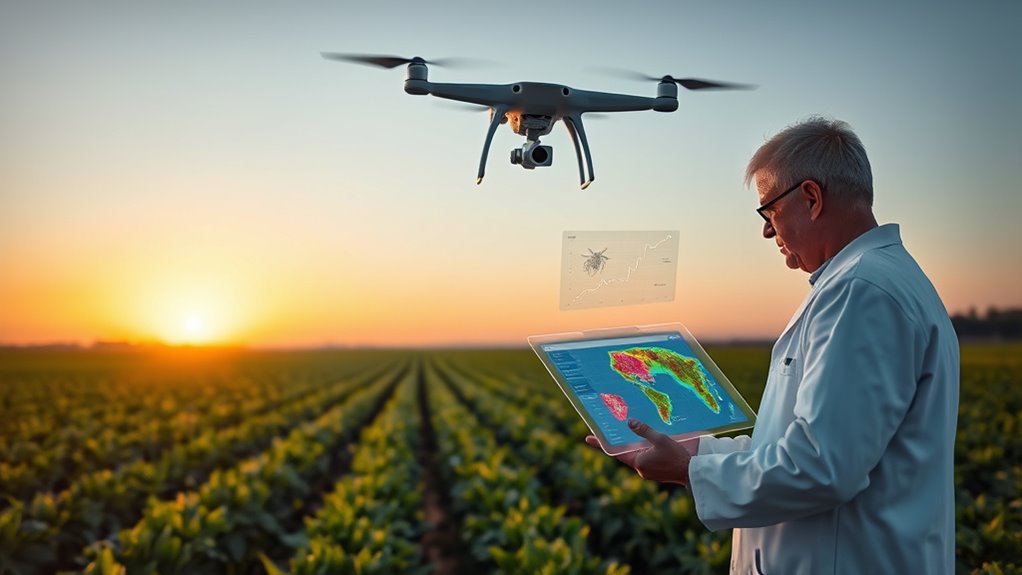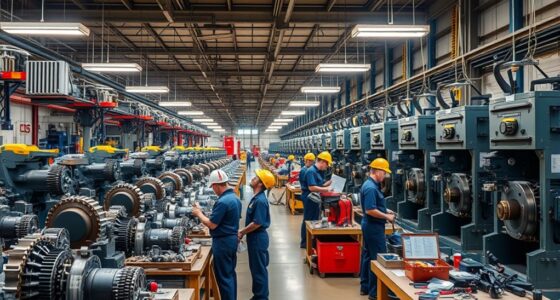Using AI and data analytics helps you predict pest outbreaks more accurately by analyzing weather patterns, satellite images, and historical trends. These tools identify environmental conditions that favor pests, track crop health, and monitor soil moisture in real time. Machine learning models recognize early signs of infestations, enabling timely and targeted interventions. By combining these technologies, you can reduce chemical use and improve crop yields. To discover how to implement these approaches effectively, continue exploring these solutions.
Key Takeaways
- AI models analyze weather, satellite, and historical data to identify environmental patterns linked to pest outbreak risks.
- Machine learning algorithms detect early pest population indicators, enabling proactive and targeted pest management strategies.
- Satellite technologies monitor land surface changes, vegetation health, and soil moisture to predict pest habitat suitability.
- Data analytics improve prediction accuracy over time by integrating real-time environmental variables and crop health indicators.
- Implementing AI-driven forecasting supports precise interventions, reducing chemical use and increasing crop yields.
The Role of Weather Data in Pest Prediction

Weather data plays a crucial role in predicting pest outbreaks because pests are highly sensitive to environmental conditions. You need to monitor temperature, humidity, rainfall, and wind patterns, as these factors directly influence pest development and movement. For example, warm temperatures can accelerate pest life cycles, while excessive rainfall might reduce their populations or spread them to new areas. By analyzing historical weather trends alongside current data, you can identify conditions that favor pest outbreaks. This allows you to anticipate problems before they become severe, enabling timely interventions. Accurate weather data helps you understand the timing and scale of potential outbreaks, so you can implement targeted, effective pest management strategies and reduce reliance on chemical controls.
Leveraging Satellite and Remote Sensing Technologies

Satellite and remote sensing technologies provide a powerful means to monitor environmental conditions over large and inaccessible areas, complementing traditional weather data. These tools give you real-time insights into land surface changes, vegetation health, soil moisture, and temperature patterns. With satellite imagery, you can:
Satellite data offers real-time insights into land changes, vegetation, soil moisture, and temperature patterns.
- Detect early signs of stress in crops, such as discoloration or wilting.
- Track seasonal vegetation growth and density variations.
- Monitor moisture levels in soil critical for pest habitat suitability.
- Observe temperature fluctuations that influence pest activity cycles.
- Nutrient-rich ingredients in satellite data can help identify areas with optimal conditions for pest proliferation.
Machine Learning Models for Pest Forecasting

Machine learning models have become essential tools for predicting pest outbreaks with greater accuracy and timeliness. By analyzing large datasets, these models identify complex patterns that traditional methods might miss. You can input weather data, crop information, and environmental variables to train algorithms like decision trees, neural networks, or support vector machines. These models learn to recognize early indicators of pest population surges, enabling proactive responses. They adapt as new data becomes available, improving their predictions over time. With machine learning, you gain faster insights, reducing reliance on manual scouting and guesswork. This approach helps you allocate resources efficiently, minimize crop damage, and implement targeted pest management strategies before outbreaks escalate. Additionally, integrating AI-driven analytics enhances cyber threat detection and safeguards sensitive data related to agricultural systems. Overall, machine learning transforms pest forecasting into a precise, data-driven process.
Integrating Historical Pest Data and Trends

Incorporating historical pest data and trends into your predictive models allows for a deeper understanding of outbreak patterns over time. This approach helps you identify recurring cycles and seasonal peaks. To do this effectively: 1. Gather long-term data from various sources, like field surveys and historical records. 2. Analyze past outbreaks to detect common triggers and environmental conditions. 3. Identify trends that correlate pest activity with weather patterns, planting cycles, or crop susceptibility. 4. Use these insights to refine your models, making predictions more accurate and reliable. Additionally, understanding pest behavior and its response to environmental factors can further improve prediction accuracy.
Real-Time Monitoring and Early Warning Systems

Real-time monitoring and early warning systems enable you to detect pest outbreaks as they develop, giving you the chance to respond swiftly and effectively. By utilizing sensors, drones, and remote sensing technologies, you gather continuous data on pest activity and environmental conditions. AI algorithms analyze this data instantly, identifying abnormal patterns that signal potential infestations. This immediate insight allows you to implement targeted interventions before pests cause significant damage. These systems can also integrate weather forecasts and crop health data, enhancing prediction accuracy. As a result, you reduce unnecessary pesticide use and minimize crop losses. Real-time monitoring empowers you to make informed decisions quickly, improving pest management efficiency and sustainability. It’s a proactive approach that keeps you ahead of outbreaks, safeguarding your crops and resources. Incorporating predictive analytics into these systems further refines the ability to forecast pest trends and outbreaks before they occur.
Challenges and Future Directions in AI Pest Management

You’ll face challenges like ensuring data quality and consistency, which are crucial for accurate predictions. Model interpretability can also be tricky, making it harder for you to trust and act on AI recommendations. Additionally, integrating these technologies into existing field practices requires careful coordination and adaptation. Developing robust data collection methods is essential to improve the reliability of pest outbreak forecasts.
Data Quality Concerns
Despite the promise of AI and data analytics in predicting pest outbreaks, data quality remains a significant hurdle. Poor data can lead to inaccurate predictions and ineffective pest management strategies. Here are some key issues:
- Incomplete data sets that miss critical pest or environmental information.
- Inconsistent data collection methods across regions or timeframes.
- Errors and noise introduced during data entry or sensor readings.
- Lack of standardized formats, making data integration difficult.
- Ensuring the integrity of data is crucial for building reliable models and effective pest prediction systems.
These problems hinder the development of reliable models. Improving data quality involves establishing standardized collection protocols, investing in accurate sensors, and ensuring data validation. Without addressing these concerns, AI-driven pest prediction risks becoming unreliable and less impactful.
Model Interpretability Challenges
While AI models offer powerful tools for predicting pest outbreaks, their complexity often makes it difficult to understand how they arrive at specific predictions. This lack of transparency can hinder trust and decision-making, especially when actions impact crop health and livelihoods. Interpreting these models requires expertise, which many practitioners lack, creating a gap between technology and field application. To highlight this, consider the emotional impact:
| Challenge | Impact |
|---|---|
| “Black box” models | Uncertainty and mistrust among users |
| Complex algorithms | Difficulty in explaining decisions |
| Limited interpretability | Hesitation to act on predictions |
| Lack of visual tools | Frustration and confusion |
| Need for transparency | Desire for clearer, trustworthy insights |
Addressing these challenges is essential to making AI tools more accessible and effective in pest management. Additionally, improving model interpretability can foster greater confidence and collaboration between developers and end-users.
Integration With Field Practices
Integrating AI tools into traditional field practices presents both significant opportunities and notable challenges. You might face issues like:
- Training and Adoption: Farmers need to learn new technologies, which may require time and resources.
- Data Collection: Gathering accurate, real-time data in diverse field conditions can be difficult.
- Equipment Compatibility: Existing tools may not seamlessly integrate with AI platforms, causing delays.
- Decision-Making Confidence: Relying on AI predictions demands trust, which can take time to build among practitioners.
- Understanding Pest Behavior: Incorporating knowledge of Halloween traditions and practices can inform the timing and deployment of pest management strategies, especially when considering seasonal behavioral patterns.
Despite these hurdles, successful integration can lead to more precise pest management, reduced chemical use, and increased crop yields. Overcoming these challenges involves ongoing education, infrastructure investment, and building user trust in AI-driven insights.
Frequently Asked Questions
How Accurate Are AI Predictions Compared to Traditional Pest Forecasting Methods?
AI predictions are generally more accurate than traditional pest forecasting methods because they analyze large datasets quickly and identify complex patterns often missed by manual methods. You benefit from real-time updates, improved precision, and early detection, allowing you to take proactive measures. While no method is perfect, AI’s ability to adapt and learn from new data makes it a powerful tool for more reliable pest outbreak predictions.
What Types of Pests Can AI and Data Analytics Effectively Predict?
You can use AI and data analytics to effectively predict various pests like insects, rodents, and plant diseases. These tools analyze environmental data, weather patterns, and historical outbreaks to forecast pest activity accurately. By identifying high-risk periods and areas, you can target control measures more efficiently. This proactive approach helps minimize crop damage, reduce pesticide use, and improve overall pest management strategies.
How Do Data Privacy Concerns Impact AI Pest Management Systems?
You might not realize, but 60% of farmers worry data privacy could limit AI’s effectiveness in pest management. Privacy concerns impact AI systems because you need access to detailed, sensitive data to make accurate predictions. If data isn’t protected or shared cautiously, you risk breaches or mistrust. Ensuring robust security measures encourages data sharing, helping you make smarter pest control decisions without compromising privacy.
Can Small Farms Afford Advanced AI Pest Prediction Tools?
Small farms can afford advanced AI pest prediction tools through affordable options like cloud-based services and open-source platforms. These solutions often have flexible pricing models, making them accessible for limited budgets. You might also share resources with neighboring farms or participate in cooperatives to reduce costs. Investing in these tools can save you money in the long run by preventing pest outbreaks and reducing pesticide use, ultimately boosting your farm’s productivity.
What Ethical Considerations Exist in Using AI for Pest Control Decisions?
You might worry about AI making unfair or biased pest control decisions, but transparency is key. You should guarantee AI systems are designed ethically, with clear data sources and accountable algorithms. It’s essential that these tools respect privacy, avoid discrimination, and involve farmers in decision-making. By addressing these ethical considerations, you can confidently use AI to improve pest management while maintaining fairness and trust.
Conclusion
By harnessing AI and data analytics, you gain the power to predict pest outbreaks before they happen, turning uncertainty into control. While weather patterns and satellite data paint a vivid picture, it’s your real-time monitoring and smart algorithms that truly make a difference. Yet, amidst these advancements, challenges remain. Embrace the future with optimism, knowing that blending technology with nature’s complexity can help you protect your crops and sustain your harvest—before pests have a chance to strike.










